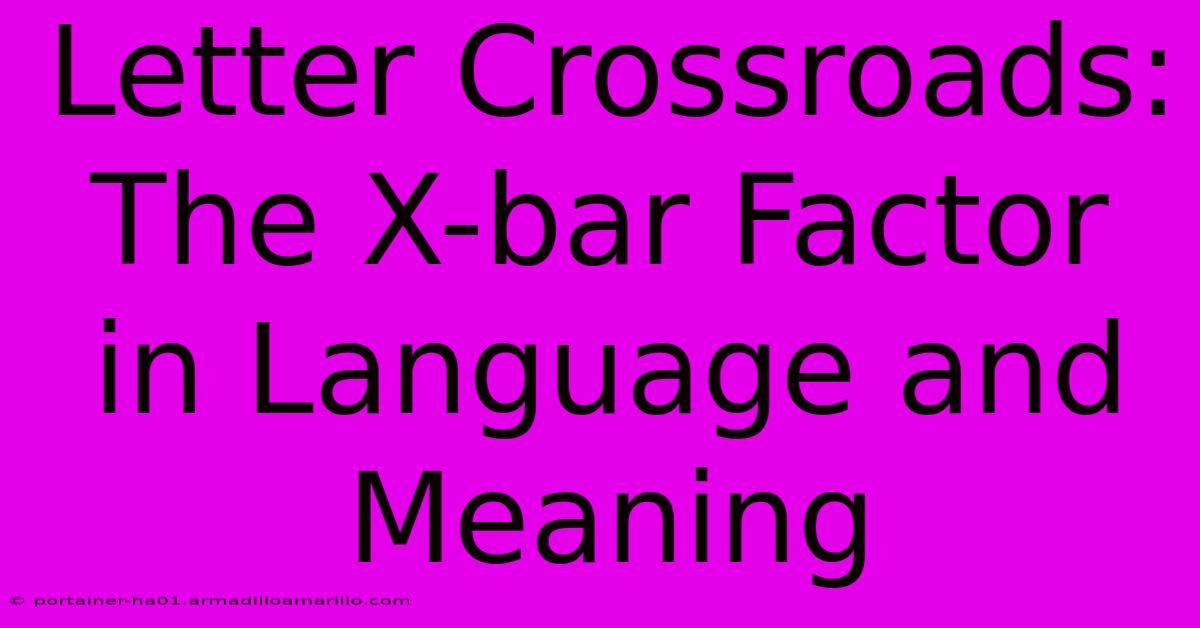Letter Crossroads: The X-bar Factor In Language And Meaning

Table of Contents
Letter Crossroads: The X-bar Factor in Language and Meaning
The humble letter "X," a crossroads of lines, a symbol of the unknown, holds a fascinating position in linguistics. It's not just a letter; it represents a crucial concept in understanding the structure of phrases and sentences: the X-bar theory. This theory, a cornerstone of generative grammar, provides a powerful framework for analyzing the hierarchical organization of language, offering insights into how meaning is constructed. This article delves into the significance of the X-bar schema, explaining its components and demonstrating its application in unraveling the complexities of language.
Understanding the X-bar Schema: A Universal Grammar Framework
The X-bar schema, represented symbolically as X', X'', and X, is not about the letter "X" itself, but rather a generalized representation of any syntactic category. Think of "X" as a placeholder for nouns (N), verbs (V), adjectives (A), prepositions (P), etc. This elegant simplicity allows the schema to be applied universally across different languages, suggesting a fundamental underlying structure in human language acquisition.
The Levels of the X-bar Schema:
-
X (the Head): This is the core of the phrase – the noun in a noun phrase, the verb in a verb phrase, and so on. It's the lexical item around which the phrase is built. For example, in the noun phrase "the big red ball," "ball" is the X (head).
-
X' (the Intermediate Phrase): This level adds modifiers or complements directly related to the head. In our example, "red ball" would be X', adding the adjective "red" to modify the head noun "ball".
-
X'' (the Maximal Phrase): This is the complete phrase, incorporating all the elements. Our full noun phrase "the big red ball" is X'', with the determiner "the" and the adjective "big" added to the intermediate phrase.
Applying the X-bar Schema: Examples and Analysis
Let's see the X-bar schema in action with a few examples:
1. Noun Phrase (NP):
- X (N): cat
- X' (N'): lazy cat
- X'' (NP): the lazy cat
This shows how the head noun "cat" is modified by "lazy" to form N', and the determiner "the" is added to create the complete NP.
2. Verb Phrase (VP):
- X (V): ran
- X' (V'): ran quickly
- X'' (VP): ran quickly through the park
Here, the head verb "ran" is modified by the adverb "quickly" (V'), and the prepositional phrase "through the park" is added to form the complete VP.
3. Prepositional Phrase (PP):
- X (P): in
- X' (P'): in the garden
- X'' (PP): in the beautiful garden
This example demonstrates how the preposition "in" is combined with the NP "the garden" (P'), further modified by the adjective "beautiful" to create the full PP.
Beyond the Basics: The Significance of X-bar Theory
The X-bar schema is more than just a descriptive tool. It offers crucial insights into:
- Universality in Language: Its applicability across different languages points towards underlying universal principles in human language structure.
- Phrase Structure Rules: It provides a formal framework for defining phrase structure rules, enabling a more precise and systematic analysis of sentence construction.
- Ambiguity Resolution: By revealing the hierarchical structure, it helps resolve ambiguities in sentence meaning.
- Language Acquisition: It offers a potential model for how children acquire the complex grammatical structures of their native language.
Conclusion: The Enduring Impact of X-bar
The X-bar schema, though seemingly simple in its representation, provides a powerful and insightful framework for understanding the architecture of language. Its application extends far beyond basic sentence analysis, offering crucial insights into the fundamental principles of human language and its remarkable capacity for complex meaning creation. The seemingly simple "X" thus becomes a potent symbol of the intricate and fascinating world of linguistics.

Thank you for visiting our website wich cover about Letter Crossroads: The X-bar Factor In Language And Meaning. We hope the information provided has been useful to you. Feel free to contact us if you have any questions or need further assistance. See you next time and dont miss to bookmark.
Featured Posts
-
Geenery Filler The Secret To Transform Your Home Into An Oasis
Feb 06, 2025
-
Instellation Focused Titles
Feb 06, 2025
-
Uncover The Secrets Of Healthy Ears Consult An Ear Doctor Near Me
Feb 06, 2025
-
Unleash Your Creativity The Essential Wireframe Examples For Your Portfolio
Feb 06, 2025
-
Letter Landmarks What The X Bar Tells Us About Word Structure
Feb 06, 2025
